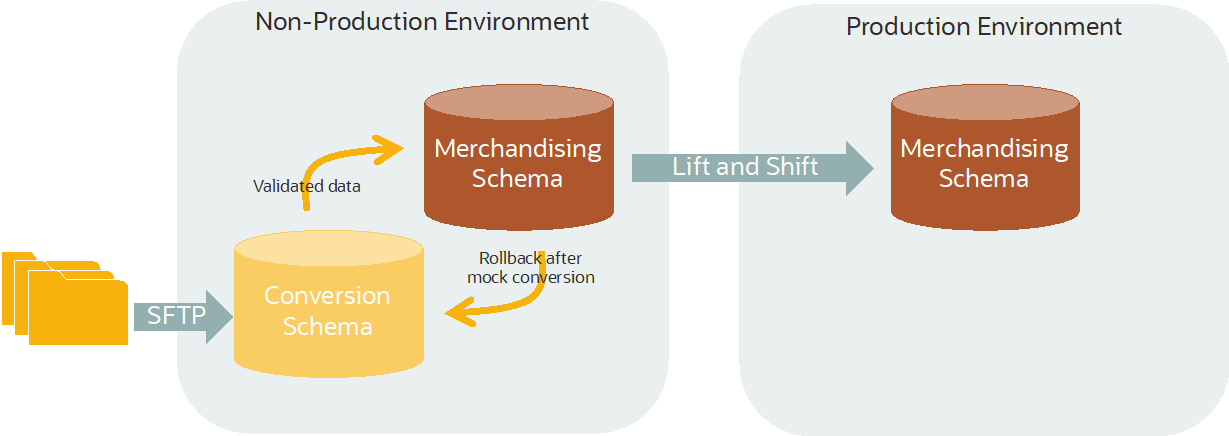| Oracle® Retail Merchandising Conversion Implementation Guide Release 19.2.000 F37376-03 |
|
 Previous |
 Next |
| Oracle® Retail Merchandising Conversion Implementation Guide Release 19.2.000 F37376-03 |
|
 Previous |
 Next |
As part of the provisioning process, you should receive the links to access the application from the cloud engineering team, along with information on how to SFTP files into the environment. The link for accessing the tool is like the below, with the hostname being replaced by what is applicable for your environments.
https://xxx-yyy-mfcs-rhs.oracleindustry.com/DataConversion/faces/Home
Details on configuring the SFTP connections that will be used for data conversion as well as other areas in Merchandising can be found in the Merchandising Administration Guide.
To get started with using the Data Conversion application, you will first need to configure users for the roles, duties and privileges of the application. There are two roles by default that have been configured for this application:
Data Conversion Operator (DATACONV_OPERATOR_JOB)
Data Conversion Administrator (DATACONV_ADMIN_JOB)
| Duty | Priv | Description |
|---|---|---|
| Data Clean-up Duty | Data Clean-up Priv | By default, this is assigned to the administrator role only. This privilege allows for access to the System Administration screen. |
| Data Inquiry Duty | Data Viewer Priv | This privilege allows for access to the View Uploaded Data screen. |
| Data Validation Duty | Basic Data Validation Priv | This privilege allows for access to the Data Validation screen. |
| Business Data Validation Priv | This privilege allows for access to the Business Validation screen. | |
| Mass Upload Duty | Mass Upload Priv | This privilege allows for access to the Mass Upload screen. |
| Report Viewer Duty | Report Viewer Priv | This privilege allows for access to the in-context reports. |
As with other roles, the data conversion roles are associated with users in the Identity Cloud Service (IDCS)Foot 1 and the duties and privileges assigned to the roles are managed in the Oracle Retail Application Administration Console (ORAAC)Foot 2 . Each of the screens and functions noted above will be described in more detail later in this document.
The diagram below shows, at a high level, how the conversion schema is set up in relation to your non-production environment. Files are imported via SFTP into the conversion schema and then validated data is loaded into the non-production Merchandising schema.
It is expected that you will iterate multiple times, loading data and validating between the conversion schema and the Merchandising schema. Once you have validated, the data is all loaded correctly in the non-production environment, including the running of any custom scripts to load data not supported in the tool, you will coordinate with the Oracle Cloud Operations team to load the data into production, often referred to as "Lift and Shift". The rest of this document will describe in more details how the conversion tool supports this high-level flow of data.

Data filtering in Merchandising should be turned off during data conversion activities. It can be re-enabled after conversion is completed.
All system option configurations in Merchandising and Pricing are updated as appropriate for your implementation prior to starting the conversion. You can peform this via the UI or by updating directly in the non-production environment schema using APEX Data Viewer.
Because of changes that may occur to foundation data structures during a major update, it is recommended that you clear the data conversion environment using the Mock Conversions functionality and reload what you previously had converted (with updates to templates as needed) before continuing the conversion.
The Data Conversion application is supported in English only. However, the converted data can and should be loaded in the primary language for your implementation, with additional translations included where applicable.
Footnote Legend
Footnote 1: For more information on managing users and roles in IDCS, see Managing Users, User Accounts, and Roles